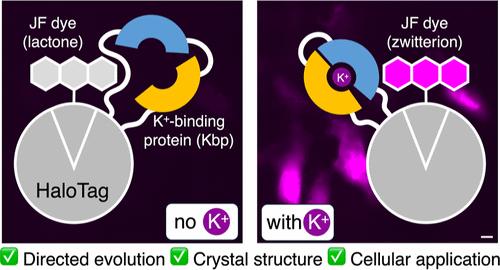High-Performance Chemigenetic Potassium Ion Indicator
IF 15.6
1区 化学
Q1 CHEMISTRY, MULTIDISCIPLINARY
引用次数: 0
Abstract
Potassium ion (K+) is the most abundant metal ion in cells and plays an indispensable role in practically all biological systems. Although there have been reports of both synthetic and genetically encoded fluorescent K+ indicators, there remains a need for an indicator that is genetically targetable, has high specificity for K+ versus Na+, and has a high fluorescent response in the red to far-red wavelength range. Here, we introduce a series of chemigenetic K+ indicators, designated as the HaloKbp1 series, based on the bacterial K+-binding protein (Kbp) inserted into HaloTag7 self-labeled with environmentally sensitive rhodamine derivatives. This series of high-performance indicators features high brightness in the red to far-red region, large intensiometric fluorescence changes, and a range of Kd values. We demonstrate that they are suitable for the detection of physiologically relevant K+ concentration changes such as those that result from the Ca2+-dependent activation of the BK potassium channel.

高性能化学钾离子指示剂
钾离子(K+)是细胞中含量最高的金属离子,在几乎所有生物系统中都发挥着不可或缺的作用。虽然已有关于合成和基因编码荧光 K+ 指示剂的报道,但仍然需要一种可基因靶向、对 K+ 和 Na+ 具有高度特异性、在红色至远红色波长范围内具有高荧光响应的指示剂。在此,我们介绍了一系列化学遗传 K+ 指示剂,命名为 HaloKbp1 系列,该系列基于插入 HaloTag7 的细菌 K+ 结合蛋白(Kbp),自标记环境敏感的罗丹明衍生物。该系列高性能指示剂具有红至远红区域亮度高、荧光强度变化大和 Kd 值范围广的特点。我们证明,它们适用于检测生理相关的 K+ 浓度变化,如 Ca2+ 依赖性激活 BK 钾通道所产生的变化。
本文章由计算机程序翻译,如有差异,请以英文原文为准。
求助全文
约1分钟内获得全文
求助全文
来源期刊
CiteScore
24.40
自引率
6.00%
发文量
2398
审稿时长
1.6 months
期刊介绍:
The flagship journal of the American Chemical Society, known as the Journal of the American Chemical Society (JACS), has been a prestigious publication since its establishment in 1879. It holds a preeminent position in the field of chemistry and related interdisciplinary sciences. JACS is committed to disseminating cutting-edge research papers, covering a wide range of topics, and encompasses approximately 19,000 pages of Articles, Communications, and Perspectives annually. With a weekly publication frequency, JACS plays a vital role in advancing the field of chemistry by providing essential research.

 求助内容:
求助内容: 应助结果提醒方式:
应助结果提醒方式:


